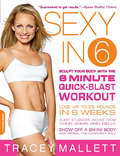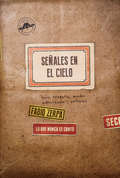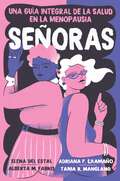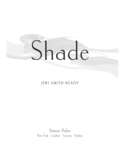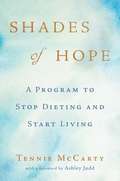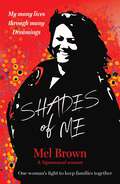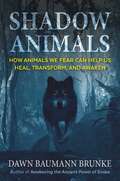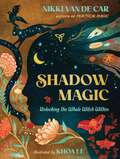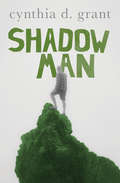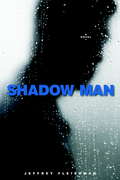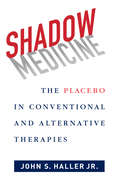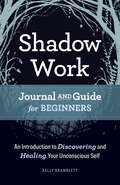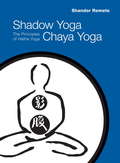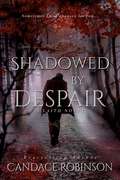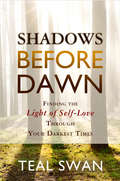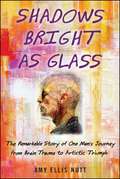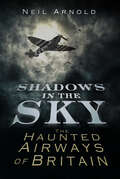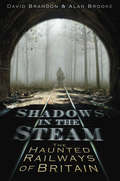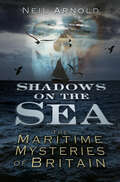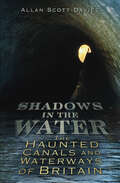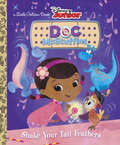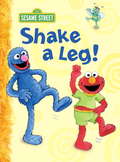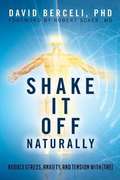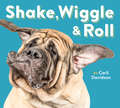- Table View
- List View
Sexy in 6: Sculpt Your Body with the 6 Minute Quick-Blast Workout
by Tracey MallettDon't have time to hit the gym? You can get a bikini body in just six weeks-in your spare time! Proven effective for all body types, Sexy in 6 offers highly motivating, super-fast workouts that are easy to squeeze into a busy day, plus a simple diet plan and delicious recipes. Split into six-minute training intervals, the plan uses a unique blend of Pilates, yoga, cardio, and strength training-even exercises to make sex better-to help you lose up to twenty-five pounds. With Sexy in 6, you can find the time, lose the weight, and regain confidence.
Señales en el cielo: Lo que nunca se contó. Ovnis, telepatía, mundos subterráneos y profecías
by Fabio ZerpaFabio Zerpa cuenta sus inicios, y condensa sesenta años de investigación recorriendo el mundo y entrevistando a personas que aseguran haber visto objetos voladores. Profecías, teorías, vidas paralelas y mundos subterráneos. 17 de noviembre de 1959. Fabio Zerpa, un joven actor que ocupaba un sitio incipiente pero importante en el teatro y la televisión, estaba grabando escenas en una base aérea. Durante el descanso, el piloto que hacía de su doble de riesgo lo invitó a dar un paseo en avioneta. Ascendieron a ochocientos metros de altura. Volaban señalándose curiosidades del paisaje, bromeando, cuando de pronto el piloto se puso serio y le indicó a Fabio que mirara a su izquierda y detrás. "Yo giré la cabeza para ver más allá de la cola del avión y vi algo así como un bolígrafo metálico plateado de unos ciento cincuenta metros de largo volando, siguiéndonos -recuerda Zerpa-. Increíblemente, se detuvo un instante frente a la cabina de nuestro avión. Y, de pronto, realizó un movimiento de sesenta grados y se perdió en el cielo a gran velocidad, hacia el norte. Todo en silencio. Estaba muy impresionado. Busqué en ese cielo clarísimo una nueva señal, pero nada. Así como había aparecido, había dejado su ausencia, tan enorme como mi asombro." La visión de ese objeto marcaría su destino para siempre. Como al mejor de los artistas o de los sabios, a Fabio Zerpa lo fascinó un misterio y le dedicó su vida. Durante sesenta años investigó, se entrevistó con personas de todo el mundo, y fue detrás de pistas y datos que documentó con fervor y precisión. Este libro es una historia de vida, la de un hombre que convirtió sus días en una película de ciencia ficción; pero también la búsqueda incansable y monumental de respondernos: "¿Qué hay más allá?". «Conocí a Fabio Zerpa en los años setenta. Ya era un gran investigador. Su trabajo ha sido titánico. Solo los que investigamos por las carreteras lo sabemos. La historia, algún día, le hará justicia.» Juan José Benítez
Señoras: Una guía integral de la salud en la menopausia
by Elena Del Estal Perez Alberta Maria Fabris Adriana Fernandez Caamaño Tania Rodriguez Manglano«Un libro eminentemente práctico y útil para transitar con elegancia por la temida menopausia». —Anna Freixas, autora bestseller de Nuestra menopausia¿Qué hacer con los sofocos? ¿Es normal que vuelva la regla después de tanto tiempo (¡y justo el día que usas pantalones blancos!)? ¿Se puede prevenir la osteoporosis? ¿Adónde se fue el deseo?Para muchas mujeres, la menopausia es un terreno incierto, más cercano a una enfermedad o una tortura que una etapa vital digna de ser disfrutada. Sin embargo, cuando disponemos de las herramientas y la orientación adecuadas, es posible transformar radicalmente esta experiencia.Señoras es una guía práctica y compasiva, escrita por cuatro profesionales de la salud con una perspectiva feminista, donde encontrarás todo lo que necesitas saber y escuchar sobre la menopausia y el climaterio. Desde explicaciones científicas y rutinas de ejercicios ilustradas, hasta reflexiones en torno a los prejuicios médicos y sociales que invisibilizan los «asuntos de mujeres».Sin importar si ya estás transitando o no este camino, estas páginas serán tus mejores aliadas para vivir una madurez plena, libre de miedos y prejuicios. Como una verdadera señora. -----A comprehensive guide to celebrate and embrace maturity without fear or prejudice. What to do about hot flashes? Is it normal for your period to come back after so long (and on the day you’re wearing white pants, no less!)? Can osteoporosis be prevented? Where did your sex drive go?For many women, menopause is an uncertain terrain, more like an illness or torture than a vital stage worth enjoying. However, with the right tools and guidance, this experience can be radically transformed.Señoras is a practical and compassionate guide, written by four health professionals from a feminist perspective, where you’ll find everything you need to know and hear about menopause and the climacteric. From scientific explanations and illustrated exercise routines to reflections on the medical and social biases that render “women’s issues” invisible.Whether or not you’re already on this journey, these pages will be your best allies in living a full maturity, free from fear and prejudice. Like a true señora.
Shade
by Jeri Smith-ReadyAura can see ghosts. Born after the Shift, a little-understood event that enabled younger generations to communicate with the dead, Aura is relentlessly pursued by these violet-hued spirits. They need help to pass out of this world and into the next. And some are so angry they are on the verge of becoming Shades, dark vortexes of energy. But Aura just wants the ghosts to leave her alone so she can spend time with her boyfriend, Logan. When Aura is paired with a new foreign-exchange student to research the Shift for a class project, she is determined to ignore her partner’s sexy Scottish accent and discover the cause of the Shift so she can reverse it. Then Logan dies a most untimely death. Forced to reconsider her relationship with the living and the dead, Aura is caught in a love triangle with her violet-hued boyfriend and her hot research partner... one of whom may hold the key to reversing the Shift.
Shades of Hope
by Ashley Judd Tennie MccartyThere are millions of people who bounce from one diet to another with no understanding of the link between emotional eating (compulsive overeating) and not being able to keep off the weight. Author Tennie McCarty was herself an overeater, food addict, and bulimic. Tennie believes that food addiction is a physical and mental problem with a spiritual solution. Tennie confronted her addictions to unhealthy relationships, food, work, and was finally able to find the one thing we all ultimately crave--serenity. In her work with clients, Tennie helps them uncover why they yo-yo diet, why they compromise their health with a diseased relationship to food, why their uncontrollable need for control has left them feeling broken, and what it is about their past or present that leads them to seek comfort in the oscillating consumption and restriction of food. As Ashley Judd, a former patient says, "Because if there was hope for Tennie McCarty, there was hope for me." Using her trademark humor, in Shades of Hope Tennie offers real-life solutions and a step-by-step program that teaches you how to let go of the bad feelings that have imprisoned you and the never-ending cycle of diets, binges, negative behaviors and broken promises.
Shades of Me: My Many Lives Through Many Dreamings
by Mel BrownMelinda Brown (Ngunnawal woman) shares the story of discovering her heritage and how the journey to understand her culture gave her the strength to find her place in the world.
Shadow Animals: How Animals We Fear Can Help Us Heal, Transform, and Awaken
by Dawn Baumann Brunke• Explains how the animals we fear or dislike can help us recognize and investigate our shadow side: the hated, abandoned, judged, and denied aspects of ourselves• Explores the lessons of a wide variety of shadow animals, including snakes, rats, bats, and spiders, as well as those that only seem shadowy to some, such as dogs, cats, birds, and horses• Looks at the elements of the psyche each shadow animal represents and presents thirteen animal-inspired exercises designed to examine, embrace, and integrate our shadow selvesWe often project qualities onto animals that we don&’t wish to admit in ourselves. Thus, snakes are evil, spiders are creepy, rats are dirty, and so on. As Dawn Baumann Brunke explains, the animals we fear or dislike can help us to recognize our Shadow: the hated, abandoned, judged, and denied aspects of ourselves. As teachers and guides, shadow animals can help us to reclaim the inner strengths, abilities, and wisdom that we have forgotten or disowned. Brunke explores the lessons of numerous shadow animals, including those that many think of as shadowy, such as snakes and bats, as well as those that only seem shadowy to some, such as dogs, cats, birds, and horses. Though shadow animals may initially appear frightening, they offer profound healing and expert guidance in helping us identify, learn from, and embrace our shadow selves. Brunke explains how shadow animals represent unexamined elements of the psyche--from secret fears and suppressed emotions to unacknowledged prejudices and repressed trauma. She presents thirteen animalinspired exercises, each uniquely designed to help us find and better understand the lost, wounded pieces of our psyche. Presenting an animal-centered guide to shadow work, Brunke reveals how shadow animals protect and advise, challenge and encourage, inspire and offer support to the spiritual adventure of enlightenment as we awaken to who we really are.
Shadow Magic: Unlocking the Whole Witch Within
by Nikki Van De Car"A necessary addition to any collection on magic and witchcraft." — Publisher's Weekly From the bestselling author of Practical Magic Nikki Van De Car comes Shadow Magic, an expansive, beautiful primer on cultivating your own innate power, magic, and strength through shadow work—the mystical art of engaging with your deepest internal self. Human beings are incredibly complex. We are more than just our happiness or sunny dispositions, and we have much to offer others and ourselves even on our worst days. There is magic and energy and potential in these moments—in the shadow—and we cannot be the fullest expression of ourselves, at our most powerful, unless we embrace and embody all that we are.Shadow Magic is here to assist you in uncovering, understanding, and celebrating your own shadow. Author Nikki Van De Car teaches us to work with the shadow, rather than trying to suppress or ignore it—allowing each of us to uncover the whole, integrated witch within. Through foundational lessons on psychologist Carl Jung's concept of the shadow; explorations of magical topics like the moon, dream magic, and symbology; and rituals and spells for connecting to your own deepest self, Shadow Magic invites all of us to harness the shadow's power to bring more magic into our lives. The spells and rituals in this book will help you bring awareness and healing to whatever you may be carrying that you would rather leave behind. As you do so, you'll uncover your personal power, including abilities and gifts that you may not have recognized within yourself. You&’ll work with sigil magic and symbology, with tarot and candle magic, with the moon, and with dreams. Each section includes three spells for you to try: one for creativity, one for intuition, and one for self-love. And along the way you'll encounter profiles of witches and women throughout history who embraced their own shadows, even when it wasn't popular. Throughout this book you will learn to embrace what it means to be in relationship with your own shadow, in a process of growth and exploration that will enhance all aspects of the self, allowing for a fuller, more magical life.
Shadow Man
by Cynthia D. GrantWhen golden boy Gabe McCloud dies in a drunk driving accident, it shakes up the whole town Everyone knew the McCloud men were bad news. The family's patriarch, Franny, only gave up drinking after almost causing an unspeakable tragedy. His sons are no better--except for Gabriel. Gabe isn't perfect, but he's handsome, charming, and friendly with just about everyone in the small, ocean-side town of Willow Creek. So after he wraps his truck around a tree one foggy night, Gabe's death affects the entire community. The tragedy opens up old wounds for some people, and brings others closer together.
Shadow Man
by Jeffrey FleishmanForeign correspondent James Ryan was there whenever the world changed: in the Middle East, in the Balkans, in the former Soviet bloc. But now he can't remember these events; he can't recall anything long-term, except the summer of his fifteenth year following his mother's death. It was the summer his father told him to call him Kurt. The summer the mysterious and enchanting Vera burst into their lonely, quiet lives. The summer his own world opened, then irrevocably changed.James, at fifty-two, suffers from a severe case of early onset Alzheimer's. The novel unravels James's predicament through the clear glimpses he retains of that long ago summer, and through the desperate attempts of his wife and his nurse to bring him back to the present, if only for stolen moments. Each has her motives: his wife trying not to lose the man with whom she shared so much - wars, death, love, loss of a child, history. And his nurse, the half sister he never knew he had, needing James's adolescent memory to understand the biological father and mother she never met. Told from the perspective of a man betrayed by his own mind, Shadow Man is a novel of identity and suspense that travels across continents and deep into the pasts that make us each who we are. It explores the power of memory to heal and to mask, and of the limits of unconditional love. Set in Philly and the eastern shore of yesteryear, in the Middle East, and throughout Eastern Europe, Fleishman's trademark descriptive but spare lyricism shines. Shadow Man is a touching and haunting novel perhaps most similar to The Diving Bell and the Butterfly, though it is a work of fiction. From the Trade Paperback edition.
Shadow Medicine: The Placebo in Conventional and Alternative Therapies
by Jr. John HallerCan Evidence Based Medicine (EBM) and Complementary and Alternative Medicine (CAM) find common ground? A distinguished historian of medicine, John S. Haller Jr., explores the epistemological foundations of EBM and the challenges these conceptual tools present for both conventional and alternative therapies. As he explores a possible reconciliation between their conflicting approaches, Haller maintains a healthy, scientific skepticism yet finds promise in select complementary and alternative (CAM) therapies. Haller elucidates recent research on the placebo effect and shows how a new engagement between EBM and CAM might lead to a more productive medical practice that includes both the objectivity of evidence-based medicine and the subjective truth of the physician-patient relationship. Haller's book tours key topics in the standoff between EBM and CAM: how and why the double blinded, randomized clinical trial (RCT) came to be considered the gold standard in modern medicine; the challenge of postmodern medicine as it counters the positivism of evidence-based medicine; and the politics of modern CAM and the rise of the National Center for Complementary and Alternative Medicine. He conducts an in-depth case study of homeopathy, explaining why it has emerged as a poster-child for CAM, and assesses CAM's popularity despite its poor performance in clinical trials. Haller concludes with hope, showing how new experimental protocols might tease out the evidentiary basis for the placebo effect and establish a foundation for some reconciliation between EBM and CAM.
Shadow Work Journal and Guide for Beginners: An Introduction to Discovering and Healing Your Unconscious Self
by Kelly BramblettHeal from trauma and embark on a journey of self-discovery with this beginner's guide to shadow workYour shadow self is the part of your mind that holds your darkest thoughts, beliefs, and memories. With shadow work, you can embrace the shadow self, overcome your limitations, and thrive. This shadow work journal for beginners is full of guided writing prompts that show you how to engage with the shadows and face the future with peace and confidence.Guidance from a professional — Author Kelly Bramblett is an experienced life coach, trauma specialist, and shadow work practitioner whose advice and expertise will keep you focused and centered as you practice.Knowing your shadow — Release your fears and achieve your goals with powerful prompts and meditations like Mind Mapping, Dreamwork, Connecting to Your Inner Child, Transmuting Shame, and more.Shadow work for beginners — If you've never tried shadow work before, this journal is the place to start! You'll get a clear introduction to shadow work and what to expect throughout your healing process.Put yourself on the path to personal growth with the reflective writing prompts in the Shadow Work Journal for Beginners.
Shadow Work Journal for Self-Love: Powerful Prompts and Exercises to Integrate Your Shadow and Embrace Your Inner Child
by Latha Jay Valerie InezHeal old wounds, break harmful cycles, and challenge the beliefs that block self-acceptance and self-love Shadow work is the process of uncovering the parts of you that you try to hide, deny, or reject and bringing them into your awareness. Over time, you learn to accept these parts and better understand who you truly are. Inevitably, this process shines a light on the root causes of deep emotional pain, invites profound healing, and creates more room for self-love. With Shadow Work Journal for Self-Love, you&’ll learn to work with your shadow parts, the needs of your inner child, and your human self so that you feel loved and accepted as a whole being. Shadow Work Journal for Self-Love features:· A practical overview of shadow work that introduces core concepts and a step-by-step approach to doing shadow work for self-love · Supportive self-care rituals to keep you engaged and help you take care of your mind, body, and spirit as you explore uncharted territory · A wide range of shadow work exercises to help you identify your shadow parts, observe them with gentle awareness, and begin the journaling process · Over 75 journaling prompts with blank pages to invite deeper exploration of your shadow self and its impact on your life
Shadow Yoga, Chaya Yoga
by Shandor RemeteIn Shadow Yoga, Chaya Yoga, author Shandor Remete shows how to utilize yoga to enhance all aspects of physical and spiritual health. Focusing specifically on the hatha tradition, the book delves deep into original Sanskrit texts, explaining the theoretical foundation of yoga in clear, encouraging language. Remete describes the "shadows" noted by classical yoga teachers that block the student, and shows ways to move beyond them. The book covers the key concepts of traditional yoga--the marmas, chakras, vayus (sources of energy), and nadis (flows of energy through the body)--before turning to the yogic techniques that improve their condition and functioning--asana (poses), nauli (abdominal exercises), pranayama (breathing), mudra (gestures), and laya (absorptions). It closes with illustrated sequences of the most important asanas. Shadow Yoga also discusses various little-understood, oft-neglected aspects of yogic training, such as the role of marma points (acupuncture-like energy points) and the influence of the zodiac. Detailed drawings of the body's energy system and its links to these elemental and planetary forces provide a visual guide to these largely unknown areas of yoga. This knowledge, considered essential in Indian yogic traditions, has been almost entirely lost in modern Western schools of yoga. Author Remete restores that information in this beautifully designed book.From the Trade Paperback edition.
Shadowed by Despair (The Laith Series #3)
by Candace RobinsonPerin expected eternal darkness after his death, yet the land of Laith has other plans for him. Snapped awake with a desperate hunger for flesh, he fights the urge to feed, knowing that once he gives in to temptation, there is no turning back. Tavarra’s deepest desire was always to be human. When she received her one true wish, the journey had already claimed those she cared about. Alone, she fights through each day, forgetting how to truly live. To strip away his new curse, Perin needs to retrieve an enchanted liquid and bring it back to the Stone of Desire. Despite his unpredictability, and him being the monster this time, Tavarra chooses to help. Tied by fate and loneliness, they must cross the sea into a deadly part of Laith and find the solution before Perin’s hunger overtakes him.Read this third installment in Candace Robinson's Laith SeriesBook 1: Clouded By EnvyBook 2: Veiled by DesireBook 3: Shadowed By Despair
Shadows Before Dawn: Finding The Light Of Self-love Through Your Darkest Times
by Teal SwanGrowing up in a tranquil wilderness, Teal Swan had a childhood that was anything but serene. Horrors lurked behind the façade of the perfect houses and pious community of the surrounding towns, and Teal attracted undue attention because of her unusually powerful extrasensory abilities. At the hands of a local cult member, she barely survived 13 years of horrendous abuse – and even after her escape, she was left powerless, lost, hurting, and with no way to cope. Gradually, and incredibly, Teal forged her way from the edge of despair to a sliver of light . . .and eventually emerged from the darkness into the full dawn of self-love. Here, she shows how you, too, can achieve the feelings of worthiness that may be long missing from your life.Now a recognized spiritual luminary, Teal documents how she dug herself out of self-hate, and details the remarkable trail for others to get to the same place. Shadows Before Dawn encompasses both Teal’s compelling story, told with raw intensity, and her resolute, no-nonsense how-to guide to healing from even the deepest levels of suffering. Offering a comprehensive self-love tool kit, Teal shares powerful exercises, insights, and perspective grounded in spirituality, and lets you choose which techniques are right for you.Teal’s resonating words will sit with your soul long after you put this book down and will serve as guideposts on the way to complete self-love – no matter who you are or where you are in life.
Shadows Bright as Glass
by Amy E NuttOn a sunny fall afternoon in 1988, Jon Sarkin was playing golf when, without a whisper of warning, his life changed forever. As he bent down to pick up his golf ball, something strange and massive happened inside his head; part of his brain seemed to unhinge, to split apart and float away. For an utterly inexplicable reason, a tiny blood vessel, thin as a thread, deep inside the folds of his gray matter had suddenly shifted ever so slightly, rubbing up against his acoustic nerve. Any noise now caused him excruciating pain. After months of seeking treatment to no avail, in desperation Sarkin resorted to radical deep-brain surgery, which seemed to go well until during recovery his brain began to bleed and he suffered a major stroke. When he awoke, he was a different man. Before the stroke, he was a calm, disciplined chiropractor, a happily married husband and father of a newborn son. Now he was transformed into a volatile and wildly exuberant obsessive, seized by a manic desire to create art, devoting virtually all his waking hours to furiously drawing, painting, and writing poems and letters to himself, strangely detached from his wife and child, and unable to return to his normal working life. His sense of self had been shattered, his intellect intact but his way of being drastically altered. His art became a relentless quest for the right words and pictures to unlock the secrets of how to live this strange new life. And what was even stranger was that he remembered his former self. In a beautifully crafted narrative, award-winning journalist and Pulitzer Prize finalist Amy Ellis Nutt interweaves Sarkin's remarkable story with a fascinating tour of the history of and latest findings in neuroscience and evolution that illuminate how the brain produces, from its web of billions of neurons and chaos of liquid electrical pulses, the richness of human experience that makes us who we are. Nutt brings vividly to life pivotal moments of discovery in neuroscience, from the shocking "rebirth" of a young girl hanged in 1650 to the first autopsy of an autistic savant's brain, and the extraordinary true stories of people whose personalities and cognitive abilities were dramatically altered by brain trauma, often in shocking ways. Probing recent revelations about the workings of creativity in the brain and the role of art in the evolution of human intelligence, she reveals how Jon Sarkin's obsessive need to create mirrors the earliest function of art in the brain. Introducing major findings about how our sense of self transcends the bounds of our own bodies, she explores how it is that the brain generates an individual "self" and how, if damage to our brains can so alter who we are, we can nonetheless be said to have a soul. For Jon Sarkin, with his personality and sense of self permanently altered, making art became his bridge back to life, a means of reassembling from the shards of his former self a new man who could rejoin his family and fashion a viable life. He is now an acclaimed artist who exhibits at some of the country's most prestigious venues, as well as a devoted husband to his wife, Kim, and father to their three children. At once wrenching and inspiring, this is a story of the remarkable human capacity to overcome the most daunting obstacles and of the extraordinary workings of the human mind.
Shadows in the Sky: The Haunted Airways of Britain
by Neil ArnoldAlthough the saying, ‘Pigs might fly…’ may bring a smile to one’s lips, even stranger things have been reported as appearing in Britain’s skies over the centuries. Eye-witnesses have testified that various terrifying and bizarre forms have appeared in the skies, from ghostly planes, phantom airships and UFOs, to reports of sky serpents, celestial dragons, flying jellyfish, rains of fish (or blood, or metal, or frogs…) – even reports of a griffin seen over London! It also considers reports of haunted aircraft hangars and airfields. Shadows in the Sky compiles hundreds of accounts from the spine-chilling to the downright bizarre, that’ll keep your eyes fixed looking upwards!
Shadows in the Steam: The Haunted Railways of Britain
by David Brandon Alan BrookeGhosts traditionally make their presence felt in many ways, from unexplained footfalls and chills to odours and apparitions. This fascinating volume takes a look at some of the strange and unexplained hauntings across the length and breadth of Britain’s railway network: signals and messages sent from empty boxes; trains that went into tunnels and never left; ghostly passengers and spectral crew; the wires whizzing to signal the arrival of trains on lines that have been closed for years… Based on hundreds of first-person and historical accounts, Shadows in the Steam is a unique collection of mysterious happenings, inexplicable events and spine-chilling tales, all related to the railways. Compiled by David Brandon and Alan Brooke, acknowledged experts on railways and the supernatural, and including sections on the London Underground and railway ghosts in literature and film, this book will delight lovers of railways and spooky stories alike.
Shadows on the Sea: The Maritime Mysteries of Britain
by Neil ArnoldSink into the depths… The great oceans of the world have long been considered alien environments said to harbor strange creatures and unfathomable mysteries. This new book from full-time monster hunter Neil Arnold examines the maritime-rich heritage surrounding the coastline of Britain and the mysterious activity said to take place there. Shadows on the Sea explores eerie stories of phantom ships upon frothing waves, sailor’s stories, fishermen’s tales and impossible monsters said to hide within the inky depths, not forgetting weird tales of USOs – unidentified submarine-type objects – and other mysterious lights witnessed out at sea. Compiling hundreds of stories and many eyewitness accounts, from the spine-chilling to the utterly bizarre, this volume is an exploration of the unknown that takes the reader on a voyage through strange tales and roaring seas.
Shadows on the Water: The Haunted Canals and Waterways of Britain
by Allan Scott-DaviesIn Shadows on the Water author Allan Scott-Davies presents a unique and fascinating collection of creepy tales and spine-chilling stories, covering locations from Cornwall to the Caledonian canals. Mixing long-established ghostly myths,this fascinating volume takes a look at some of the strange and unexplained hauntings across Britain’s canal and waterways network: echoes in dark tunnels, stone steps stained red with blood spilled long ago; ghostly footsteps accompanying barges beneath a bridge… Based on first-person and historical accounts and featuring photographs and illustrations, this collection is sure to delight lovers of the waterways and the paranormal alike.
Shake Your Tail Feathers (Little Golden Book)
by Andrea Posner-SanchezWhen Doc discovers that her stuffed owl had been squished under the toy box, she encourages Professor Hootsburgh to shake her tail feathers! A little exercise is just what all toys—and kids—need to get back in shape. This Little Golden Book based on an episode of Disney Junior&’s Doc McStuffins is perfect for boys and girls ages 2 to 5.
Shake a Leg! (Big Bird's Favorites Board Books)
by Constance Allen Maggie SwansonOkay, everybodee (as Grover would say), it's time for some exercise! So shake a leg--and every other limb--to get warmed up for some fitness and fun. Toddlers will have a good giggle as the Sesame monsters try different routines to get in shape. They can even follow along and get their own kid-sized workout--if they don't fall down laughing instead!
Shake it off Naturally: Reduce Stress, Anxiety, and Tension with (TRE)
by David Berceli<p>This book contains an easy to follow stress reduction exercise technique whose central aspect is the activation of a mild shaking response of the nervous system. It explores this most fundamental human experience of ‘shaking’ during highly excited experiences or events. This book explains how this natural shaking response is potentially capable of both relaxing physical tension patterns in the body as well as reducing psycho-emotional stress and tension. The technique explained in this book has demonstrated itself to be useful for people who are experiencing simple daily stress, long-term chronic tension, or even recovering from traumatic events. <p>This shaking response, which has been traced back through traditional cultures to present day medical science, is the body’s own natural neuro-physiological reaction to reduce stress. The combined writings of 24 authors representing 12 countries and 3 languages take the reader through the theoretical understanding of this shaking mechanism from neurological and physiological perspectives to its application with self, family, community and organizations as well as, active duty and veteran military personnel, first responders, refugee populations, and natural disaster survivors. The easy to follow pictures and explanations of these exercises guides the reader comfortably through this self-help, stress reduction process.</p>
Shake, Wiggle & Roll
by Carli DavidsonIn Shake, Wiggle & Roll, babies and toddlers will be moving and grooving with playful pups as they show off favorite doggie moves, from chomping and chewing to jumping and leaping. With lively images from the lens of expert animal photographer Carli Davidson, this sturdy book is perfect for the very youngest readers—and fun for the whole family.
